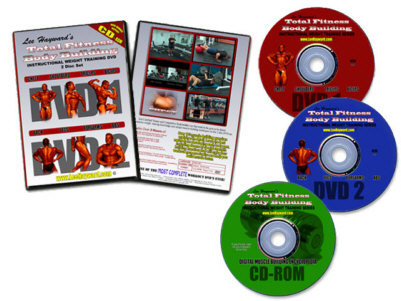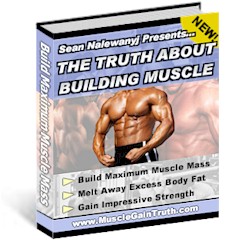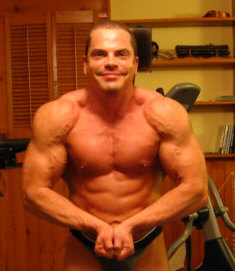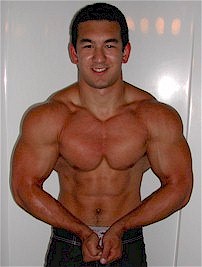
Total Fitness Bodybuilding Video Customized Diet and Training Programs Strength Training Exercise Pictures |
A few weeks ago Sean Nalewanyj (the author of the best selling e-book "The Truth About Building Muscle") interviewed me for an upcoming website feature. We went into a lot of detail about various training techniques and strategies for building maximum muscle mass, over coming training plateaus, as well as some of the tips and tricks that I use to burn fat and get in peak condition for bodybuilding competitions. Iíve posted our interview dialog here below so you can check it out for yourself. Sit back and take a few minutes to read it over, as we covered a lot of valuable training information.
Sean:
Lee:
Another big problem that I see over and over again with novice lifters is trying to get too specific and worrying about bodypart specialization before theyíve built a solid foundation. A typical scenario that I hear all too often is a new lifter who is in his first year of training and is say 6 feet tall and 150 lbs. He will e-mail me pictures of himself and ask me what I think his weak points are and what does he need to work on. For this guy bodypart specialization should be the last thing on his mind, he needs to put some meat on his bones and just get bigger and stronger all over. And then after a year or two of building a solid muscular base through the use of big basic movements he can focus on bodypart specialization and brining up any lagging muscle groups.
The nutrition side is an area where most people are really slack. Proper nutrition is without a doubt one of the most critical aspects of your bodybuilding program. You can be consistent with your workouts, but if you donít fuel your body properly you will NOT get the results you want. Period! The basic nutrition principle of eating 6 meals per day and at least 1 gram of protein per pound of bodyweight daily has been preached for years and is common knowledge in bodybuilding circles, yet it is amazing how many lifters ignore this and then wonder why they are not making gains in the gym.
Sean:
Lee:
One thing that I always do prior to looking into any new bodybuilding program is find out who the author of the program is and what is his / her background in bodybuilding and fitness. Many of the new programs that are being released now are created by people who donít even have an athletic background. A lot of these people are nothing more then sales professionals who slap together some basic bodybuilding 101 non-sense and then create a book or program to sell. They talk the talk, but donít walk the walk. To give you a real life example of this, a few months ago I was contacted by an Internet marketer who said that he has been successfully selling a stock market investment course. He told me that he wanted to capitalize on the huge fitness market and start selling a muscle building / fat loss program that he got someone to write for him and he wanted me to promote the program on my website. He went on to tell me how he was going to use all his sales tricks and techniques that he learned from selling his stock market course and apply it to selling the muscle building program. Needless to say I turned the guy down. How can someone like that offer any real world advice to aspiring bodybuilders? For example, letís say someone is looking to compete in a bodybuilding contest and wants to get down to 3% bodyfat while maintaining as much lean muscle as possible. If he approached one of these ďsalesmen bodybuilding gurusĒ how are they going to accurately help him achieve his goals when they themselves have never had a single digit bodyfat percentage and have never competed in a bodybuilding show before? It really pisses me off when a lot of so called ďbodybuilding programsĒ are created by people who are not even bodybuilders. And if you ever saw some of the authors themselves you wouldnít even say they touched a weight in their life.
Thatís a big reason why I endorse your ďTruth About Building MuscleĒ program. Not only have you done the research, but you have applied what youíve learned and built an impressive physique. You practice what you preach and I respect that.
Sean:
Lee:
I generally stick to a set routine for as long as Iím making steady strength gains with it. Once the strength gains slow down, then Iíll change it up by doing different exercise variations. For example, lets say Iím using seated barbell shoulder presses as one of my shoulder exercises. When I reach a strength plateau on that exercise I change to something else, like dumbbell shoulder press and stick with that for as long as Iím able to make strength gains. When that stops working I may change to shoulder press lockouts done in the power rack, etc. Iíll cycle through a few shoulder press variations and then when I return to the seated barbell shoulder press Iíll strive to work up past my old personal record for that exercise. Iíll follow a similar pattern for all compound exercises for each bodypart.
For isolation exercises I donít push it as hard to make strength gains each workout. There is a big difference between adding 5 lb. to a 400 lb. deadlift and adding 5 lb. to a 30 lb. dumbbell curl. With isolation movements youíll make better gains over the long term if you focus on simply working the muscles, rather then moving maximum weights. Youíll still increase the weights overtime, but there is no need to force it, youíll know when itís time to up the weights for isolation exercises.
Sean:
Lee:
But I will sometimes include some high intensity techniques with my workouts such as static holds, where on my last rep of a set Iíll just hold the weight and really squeeze and contract the muscles for about 5-10 seconds. Iíll also incorporate rest-pausing into some of my sets. For example, lets say Iím doing an exercise and I want to complete 3 sets of 10 reps with a given weight. This is the way my sets will usually go: On the first I will get all 10 reps with good form. On the second set Iíll usually have to use a slight bit of body momentum on the last few reps to complete the set as my muscles are a bit fatigued from the first set.
On the third set Iíll get about 6-8 reps and then have to put the bar down for a 10 second rest pause before completing the rest of the set.
Sean:
Lee:
For powerlifting pumping out reps until failure is actually counter productive as it limits the amount of weight you can handle. Most powerlifting routines incorporate multiple sets of low reps all stopped short of failure. Generally powerlifters never train until failure unless they miss a lift or they are doing some lighter assistance exercises after they have finished doing their main lifts.
Sean:
Lee:
But if I was forced to only choose one exercise for each muscle group my choices would be:
Chest: barbell bench press
Sean:
Lee:
With most sports once you leave the playing field, gym, or whatever you are done for the day. But with bodybuilding it is a 24 hour a day endeavor. Youíve got to keep track of every morsel of food that you eat. Most folks love the weight training, they can even handle the cardio without too much complaining, but when it comes to the diet this is where most people break down and lose it. For me I like to start my contest prep early and give myself plenty of time to get ready. I actually start cleaning up my diet and doing regular cardio 6 months out from a contest. Now at this stage Iím not starving myself or anything like that, but Iíll cut out junk foods (except for the occasional treat) and do about 45 minutes of cardio 5 days per week. As the weeks progress Iíll gradually get stricter with my eating and increase my cardio. By 12 weeks out Iím in full contest prep mode. At this stage life gets put on hold until after the show. No more cheat days, no more alcohol (not that Iím a big drinker anyway, but I will drink socially during the off-season). At this stage Iím doing at least 1 hour of cardio every single day and my diet is well regulated. Iíll stick with this basic regimen for the full 12 weeks prior to the contest. For me motivation has never been a big problem, Iíve been doing this for so long now that it is almost like flicking a switch and boom Iím in contest prep mode. The desire to improve and look better then I did at my previous contest motivates me to keep pushing and keep strict with my routine. I re-organize my thinking so that when I see junk food, sweets, etc. instead of thinking how good it tastes, or getting cravings, etc. I automatically think that this will ruin my physique and destroy my chances of placing well at the show, so I actually get disgusted by the thought of it. And then to help confirm this I just look around at all the fat obese people that I see out in public or at the grocery store who are filling their shopping carts with junk and crap. I just say to myself ďif I eat that Iíll look like themĒ and thatís motivation enough for me to stay the hell away from eating something I shouldnít be eating. Iím actually 11 weeks out from a bodybuilding contest right now. So Iím in the ďlife is put on holdĒ mode as we speak. Iím pleased with my progress thus far. Iím currently 215 lbs. @ 6% bodyfat right now and Iím planning on losing another 17 lbs. to come in at the top of the light-heavyweight class in my hardest contest condition ever.
Update: Lee ended up winning the light-heavyweight division and the overall at that bodybuilding contest. Click Here for contest pictures.
Sean:
Lee:
With bodybuilding you generally focus on working the individual bodyparts. Whereas in powerlifting the training is focused on the 3 power lifts (squat, bench press, and deadlift) and assistance exercises for the power lifts. When training the powerlifts you will combine several bodyparts into a workout that you normally wouldnít do with a typical bodybuilding routine. For example, a lot of powerlifters will train the squat and deadlift on the same day as both exercises utilize the same major muscle groups. The training will combine both leg exercises and back exercises together in the same workout. But youíll hardly ever hear of any bodybuilders training both legs and back on the same day.
My favourite powerlifting workout is the West Side Barbell style of training. I like this type of routine as it incorporates dynamic effort or speed workouts where you focus on lifting as fast and explosively as possible. This goes directly against the slow and controlled lifting that most bodybuilders do. The strength gains that you make from explosive training are amazing, especially if youíve never focused on this type of lifting before. The WSB routine also frequently changes around the max effort exercises used every few weeks so you wonít get bored with your workouts by doing the same thing over and over again.
Sean:
About Lee Hayward Lee Hayward started weight training in 1990 and has been competing in bodybuilding competitions since 1995. In January of 1999 he started his website www.LeeHayward.com and since then has helped thousands of aspiring bodybuilders from all over the world with personalized training and nutrition programs. Lee has recently put together all the valuable information that he has collected over the years into his ďTotal Fitness Bodybuilding DVD Training SystemĒ. On this digitally recorded 3 disc DVD set youíll learn the most powerful techniques for pushing your overall muscular development to a whole new level. No matter what your fitness goals are, you can start using this powerful muscle building system right now to become leaner, stronger, & more muscular than you've ever been before!

About Sean Nalewanyj
If you can spare just 24 minutes a day, then you too can build a powerful new head-turning body that will skyrocket your confidence, drive gorgeous women crazy, and leave your friends, family and co-workers staring in disbelief... ALL in just a matter of months:

|


